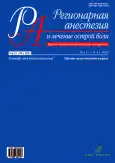Modified technique for proximal subclavicular brachial plexus block: study on unfixed cadavers
- Authors: Tsvetkov V.G.1, Lakhin R.E.1, Shchegolev A.V.1, Shustrov V.V.1, Tsygankov K.A.1
-
Affiliations:
- Military Medical Academy named after S.M. Kirov
- Issue: Vol 15, No 4 (2021)
- Pages: 267-276
- Section: Original articles
- URL: https://journals.rcsi.science/1993-6508/article/view/107956
- DOI: https://doi.org/10.17816/1993-6508-2021-15-4-267-276
- ID: 107956
Cite item
Abstract
BACKGROUND: The proximal subclavian brachial plexus block is performed deep and posterior to the midpoint of the clavicle. Only a few studies evaluated the spread of local anesthetic when using a proximal subclavian approach to the brachial plexus. We performed a cadaveric study to evaluate the spread of the injection after performing proximal subclavian brachial plexus block using ultrasound navigation.
AIM: To examine the spread of the stained solution in unfixed corpses, when it is administered using a modified technique of proximal subclavian access to the brachial plexus using ultrasound navigation.
MATERIALS AND METHODS: Six ultrasound-guided injections were performed on three unfixed cadavers using 20 ml of a colored solution. The brachial plexus and its branches were distinguished from the level of the midpoint of the clavicle to the upper third of the shoulder. The boundaries of ink distribution in relation to the bundles and terminal branches of the brachial plexus from the intersection of the upper edge of the clavicle to the upper parts of the axillary region were assessed.
RESULTS: In all cases of dye spread, the lateral, posterior, and medial bundles of the brachial plexus were stained. Terminal branch staining varied and was limited to the proximal portions of these nerves. The dye spread to the interstellar space in 2 (33%) out of 6 (100%) injections and to the level of the upper edge of the clavicle in 4 (67%) injections. The axillary and radial nerves were stained in all injections, and the ulnar nerve was stained in 4 (67%) of 6 (100%) injections. The musculocutaneous and median nerves were stained in only 2 (33%) of 6 (100%) injections. No phrenic nerve staining was observed in any case.
CONCLUSIONS: On the basis of experiment results on unfixed cadavers, injection using a modified ultrasound-guided proximal subclavian approach can fill the fascial sheath surrounding the brachial plexus with the injection material, thus causing the dye to spread around all bundles of the brachial plexus to supraclavicular space. Additional research is needed to assess whether high injection volumes or multiple injection sites can affect distribution.
Full Text
##article.viewOnOriginalSite##About the authors
Vasiliy G. Tsvetkov
Military Medical Academy named after S.M. Kirov
Author for correspondence.
Email: vasilii_cvetkov@mail.ru
ORCID iD: 0000-0003-4980-597X
SPIN-code: 5316-4617
senior resident
Russian Federation, 6, Academic Lebedev str., St. Petersburg, 194044Roman E. Lakhin
Military Medical Academy named after S.M. Kirov
Email: doctor-lahin@yandex.ru
ORCID iD: 0000-0001-6819-9691
SPIN-code: 7261-9985
MD, Dr. Sci. (Med.), assistant professor
Russian Federation, St. PetersburgAlexey V. Shchegolev
Military Medical Academy named after S.M. Kirov
Email: alekseischegolev@gmail.com
ORCID iD: 0000-0001-6431-439X
SPIN-code: 4107-6860
MD, Dr. Sci. (Med.), Prof.
Russian Federation, St. PetersburgVyacheslav V. Shustrov
Military Medical Academy named after S.M. Kirov
Email: shustrov@anesthvmeda.ru
ORCID iD: 0000-0001-5144-3360
SPIN-code: 5955-7492
Russian Federation, St. Petersburg
Kirill A. Tsygankov
Military Medical Academy named after S.M. Kirov
Email: doctorcygankov@mail.ru
ORCID iD: 0000-0002-2357-0685
SPIN-code: 7133-0503
MD, Cand. Sci. (Med.)
Russian Federation, St. PetersburgReferences
- Mamaeva EG. A new way to block the brachial plexus. Russian journal of Anaesthesiology and Reanimatology. 2006;(4):19–21. (In Russ).
- Nadeau MJ, Levesque S, Dion N. Ultrasound-guided regional anesthesia for upper limb surgery. Can J Anaesth. 2013;60(3):304–320. doi: 10.1007/s12630-012-9874-6
- Aliste J, Bravo D, Layera S, et al. Randomized comparison between interscalene and costoclavicular blocks for arthroscopic shoulder surgery. Reg Anesth Pain Med. 2019. doi: 10.1136/rapm-2018-100055
- Tran DQ, Elgueta MF, Aliste J, Finlayson RJ. Diaphragm-Sparing Nerve Blocks for Shoulder Surgery. Reg Anesth Pain Med. 2017;42(1):32–38. doi: 10.1097/AAP.0000000000000529
- Karmakar MK, Sala-Blanch X, Songthamwat B, Tsui BC. Benefits of the costoclavicular space for ultrasound-guided infraclavicular brachial plexus block: description of a costoclavicular approach. Reg Anesth Pain Med. 2015;40(3):287–288. doi: 10.1097/AAP.0000000000000232
- Demondion X, Herbinet P, Boutry N, et al. Sonographic mapping of the normal brachial plexus. AJNR Am J Neuroradiol. 2003;24(7):1303–1309. PMC7973677
- Sala-Blanch X, Reina MA, Pangthipampai P, Karmakar MK. Anatomic Basis for Brachial Plexus Block at the Costoclavicular Space: A Cadaver Anatomic Study. Reg Anesth Pain Med. 2016;41(3):387–391. doi: 10.1097/AAP.0000000000000393
- Li JW, Songthamwat B, Samy W, et al. Ultrasound-Guided Costoclavicular Brachial Plexus Block: Sonoanatomy, Technique, and Block Dynamics. Reg Anesth Pain Med. 2017;42(2):233–240. doi: 10.1097/AAP.0000000000000566
- Sivashanmugam T, Maurya I, Kumar N, Karmakar MK. Ipsilateral hemidiaphragmatic paresis after a supraclavicular and costoclavicular brachial plexus block: A randomised observer blinded study. Eur J Anaesthesiol. 2019;36(10):787–795. doi: 10.1097/EJA.0000000000001069
- Oh C, Noh C, Eom H, et al. Costoclavicular brachial plexus block reduces hemidiaphragmatic paralysis more than supraclavicular brachial plexus block: retrospective, propensity score matched cohort study. Korean J Pain. 2020;33(2):144–152. doi: 10.3344/kjp.2020.33.2.144
- Nieuwveld D, Mojica V, Herrera AE, et al. Medial approach of ultrasound-guided costoclavicular plexus block and its effects on regional perfussion. Rev Esp Anestesiol Reanim. 2017;64(4):198–205. doi: 10.1016/j.redar.2016.09.010
- Behr AU, Chan VWS, Stecco C. Living versus cadaver fascial plane injection. Reg Anesth Pain Med. 2019. doi: 10.1136/rapm-2019-100893
- Orebaugh SL, Mukalel JJ, Krediet AC, et al. Brachial plexus root injection in a human cadaver model: injectate distribution and effects on the neuraxis. Reg Anesth Pain Med. 2012;37(5):525–529. doi: 10.1097/AAP.0b013e3182660be2
- Sotthisopha T, Elgueta MF, Samerchua A, et al. Minimum Effective Volume of Lidocaine for Ultrasound-Guided Costoclavicular Block. Reg Anesth Pain Med. 2017;42(5):571–574. doi: 10.1097/AAP.0000000000000629
- Leurcharusmee P, Elgueta MF, Tiyaprasertkul W, et al. A randomized comparison between costoclavicular and paracoracoid ultrasound-guided infraclavicular block for upper limb surgery. Can J Anaesth. 2017;64(6):617–625. doi: 10.1007/s12630-017-0842-z
- Thompson GE, Rorie DK. Functional anatomy of the brachial plexus sheaths. Anesthesiology. 1983;59(2):117–122. doi: 10.1097/00000542-198308000-00009
- Monzo E, Hadzic A. Costoclavicular approach to the brachial plexus block: simple or double injection? Reg Anesth Pain Med. 2019. doi: 10.1136/rapm-2019-100852
Supplementary files












